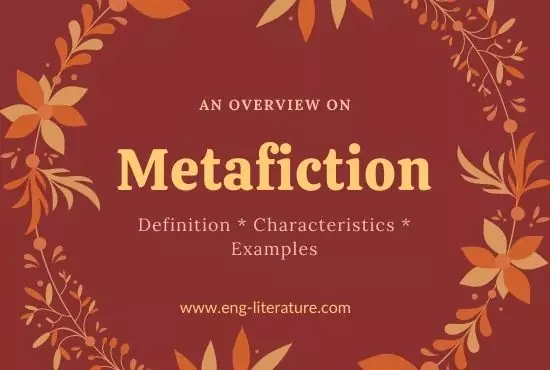Metafiction
What is Metafiction?
Metafiction is the fiction that deals, often playfully and self-referentially, with the writing of fiction or its conventions. Metafiction is also known as Romantic irony in the context of Romantic works of literature which uses techniques to draw attention to itself as a work of art, while exposing the “truth” of a story.
Few scholars claim metafiction as a type of fiction that self-consciously addresses the devices of fiction, exposing the fictional illusion. William H. Gass coined the term “metafiction” in a 1970 essay entitled “Philosophy and the Form of Fiction”. Unlike the antinovel, or anti-fiction, ‘metafiction’ is specifically fiction about fiction, i.e. fiction which self-consciously reflects upon itself.
Metafiction Definition
According to Oxford Dictionary
“Metafiction is fiction in which the author self-consciously alludes to the artificiality or literariness of a work by parodying or departing from novelistic conventions and traditional narrative techniques.”
Patricia Waugh defines the term metafiction as “fictional writing which self consciously and systematically draws attention to its status as an artifact in order to pose questions about the relationship between fiction and reality.” Metafictional works, she suggests, are those which “explore a theory of writing fiction through the practice of writing fiction”.
Mark Currie highlights current metafiction’s self-critical tendency by depicting it as “a borderline discourse a kind of writing which places itself on the border between fiction and criticism, which takes the border as its subject“. Yet, he encompasses works as metafictional by proposing that, “to see the dramatized narrator or novelist as metanarrative devices is to interpret a substantial proportion of fiction as meta-fiction”.
Historiographic metafiction is a sub genre of metafiction which was originally coined by literary theorist Linda Hutcheon. According to Hutcheon, works of historiographic metafiction are “those well-known and popular novels which are both intensely self-reflexive and yet paradoxically also lay claim to historical events and personages”. Historiographic metafiction is a quintessentially postmodern art form, with a reliance upon textual play, parody and historical re-conceptualization.
Another author often associated with historiographic metafiction is Michael Ondaatje, in works such as Running in the Family, In the skin of A Lion, The English Patient and Coming Through Slaughter. Salman Rushdie’s novels Shame and Midnight’s Children are also regarded as historiographic metafiction in their re-writing of the history of Pakistan and India in the early and mid-twentieth century.
Metafiction Characteristics
Characteristics of metafiction vary widely. These techniques employed in metafiction often appear in combination, but also can appear singularly. Victoria Orlowski narrates the characteristics of metafiction as follows:
Metafictional writers often employ intertextual references and allusions by
- examining fictional systems
- incorporating aspects of both theory and criticism
- creating biographies of imaginary writers
- presenting and discussing fictional works of an imaginary character
Authors of metafiction often violate narrative levels by
- intruding to comment on writing
- involving his or herself with fictional characters
- directly addressing the reader
- openly questioning how narrative assumptions and conventions transform and filter reality, trying to ultimately prove that no singular truths or meanings exist
Metafiction writers also use unconventional and experimental techniques by
- rejecting conventional plot
- refusing to attempt to become “real life”
- subverting conventions to transform ‘reality’ into a highly suspect concept
- flaunting and exaggerating foundations of their instability
- displaying reflexivity (the dimension present in all literary texts and also central to all literary analysis, a function which enables the reader to understand the processes by which he or she reads the world as a text)
Metafiction Examples
Metafiction is a term associated with Modernist literature and Postmodernist literature, but it is found at least as early as Homer’s Odyssey and Chaucer’s 14th century Canterbury Tales. Cervantes’ Don Quixote is a metafictional novel published in the 17th century, and so is James Hogg’s The Private Memoirs and Confessions of a Justified Sinner published in 1824.
Also Read:
Later in the 1950s several French novelists published works whose styles were collectively dubbed “nouveau roman” which were characterized by the bending of genre and style and often included elements of metafiction.
In the 1960s, with authors and works such as John Barth’s Lost in the Funhouse, Robert Coover’s The Babysitter and The Magic Poker, Kurt Vonnegut’s Slaughter house Five, Thomas Pynchon’s The Crying of Lot 49 and William H. Gass’s Willie Master’s Lonesome Wife.

Hello, Viewers! Besides being the Founder and Owner of this website, I am a Government Officer. As a hardcore literary lover, I am pursuing my dream by writing notes and articles related to Literature. Drop me a line anytime, whether it’s about any queries or demands or just to share your well-being. I’d love to hear from you. Thanks for stopping by!
